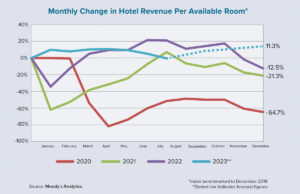Despite the difficult times facing some aspects of commercial real estate, the multifamily housing sector appears to be healthy and growing, at least in many secondary markets in the Midwest and Sun Belt regions. That is the lesson provided by Milhaus, the Indianapolis-based national multifamily developer, owner and operator of Class A residential and mixed-use communities.
The firm owns and operates a $2 billion portfolio of about 7,000 units in a wide swath of the country that includes Pittsburgh, Cincinnati, Indianapolis, Kansas City and Denver. Milhaus is also well established in the southern U.S., with properties in cities such as Charlotte, Tampa, Memphis, Dallas and Phoenix.
“We have seen strong demand … for conservatively underwritten, appropriately leveraged deals.”
Chris Beres, the company’s vice president of investor relations, spoke with Scotsman Guide this past July. He discussed the firm’s perspective on the multifamily sectors in the central and southern areas of the country, as well as prospects for real estate developments in federally designated opportunity zones.
How is the multifamily sector holding up in the secondary markets that you serve?
I think “holding up” is a pretty good term, considering all the headwinds that have impacted the real estate industry in the last 18 months or even longer, with the pandemic, rising interest rates and inflation. But multifamily demand still remains strong, particularly in the secondary markets where we are hyperfocused on building properties where there is a favorable supply-and-demand dynamic. We have seen strong demand — whether from population growth or lack of supply or both — for conservatively underwritten, appropriately leveraged deals, which are performing well in today’s higher interest rate environment.
Where are you seeing the most demand?
It is a good story across both the Midwest and the Sun Belt. Dallas has definitely been a star for us, where we delivered our first project in May — a $59 million, 279-unit property that is already 50% leased. We are seeing very strong, continued growth in the Dallas market. There is always a lot of supply in the area, but there is also plenty of demand. We also are seeing strong demand for Class A suburban properties in places such as Cincinnati, Indianapolis and Kansas City, where there are more naturally affordable price points with rents relative to local incomes. So, we are continuing to see growth in our suburban markets.
How has the lending environment changed this year?
On the debt side, we have been very fortunate. Milhaus has a great pool of diversified lenders, ranging from small local banks to regional banks, super regionals, nationals, life insurance companies and other sources. We’ve been able to get good terms. I think underwriters are very focused on sponsor quality and that helps us out quite a bit. We are still seeing attractive debt-term sheets.
On the equity side, it’s been a little bit more challenging in some cases, although we’ve been able to close deals already this year and we should be closing more in the very near future. But it takes five times the work to find partners. A year ago, you would go out to 12 sources, and you’d have four or five term sheets without too much work. Now it requires a lot more effort. There is still a lot of capital out there, but it’s mostly on the sidelines and being very selective.
One area of focus for your company is qualified opportunity zones. Explain how that works.
The opportunity zone program incentivizes investment in lower-income census tracts that were federally designated to be part of the program. The incentives are in the form of some really fantastic tax benefits. Investors with capital gains can deploy those capital gains into a qualified opportunity zone fund. This allows them to defer the payment on the capital gains until 2027. But by far the biggest benefit is that once an opportunity zone investment is held for 10 years, there are no capital gains on the investment. So, effectively, the entire investment return can be realized completely tax-free.
How many of these projects are you developing?
We’re expecting the total value to exceed $1 billion. Our projects are across seven states, ranging from Arizona to Indiana, Kansas, Missouri, Ohio, Texas and Florida. This program really has delivered in terms of bringing investment into these underserved markets. The projects will create 6,000 construction jobs; 75 full-time, on-site employees; and 3,500 units that will house about 5,000 residents. They will add more than $200 million of spending power each year to these areas. I think this program is doing a lot of good for these communities because the opportunity zones are not just bringing in residents and economic spending, they are also developing jobs in underserved areas. That makes this program especially powerful. ●






